Pradeep Kanthan
Anzac and India: A shared but forgotten camaraderie
“Before the war who had ever heard of ANZAC? Hereafter who will ever forget it?” …by saying this British Commander at Gallipoli, General Sir Ian Hamilton best summed up the spirit of Anzac.
Gallipoli was the strife of people of different races, and it has had a special impact on Australia, New Zealand, and Turkey, who have kept the spirit alive. What is not immediately remembered is that there was a significant participation by troops from India.
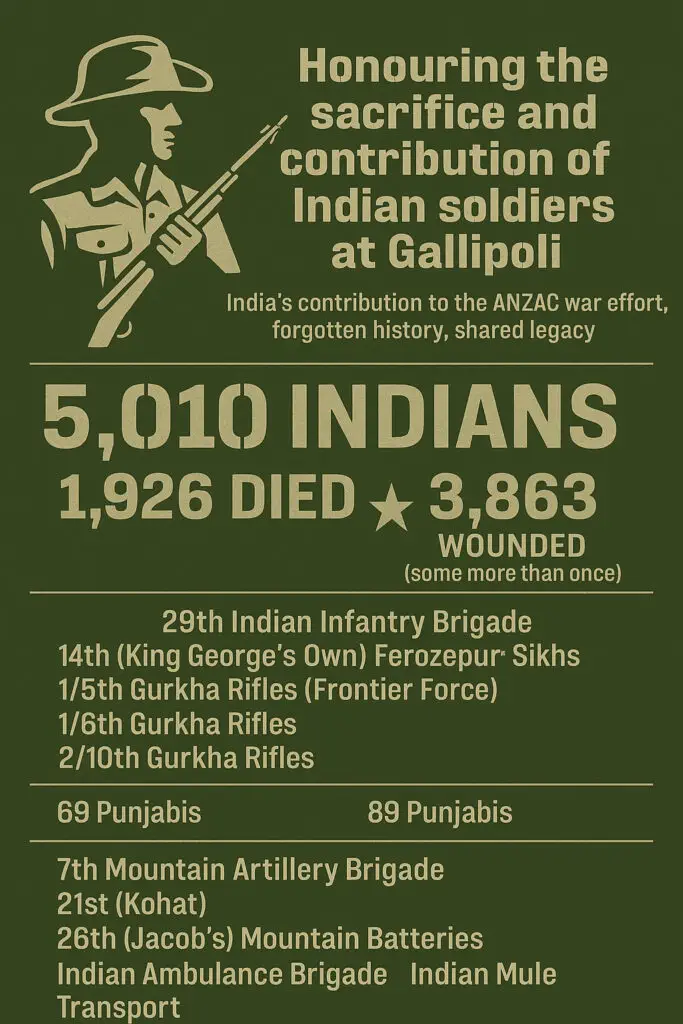 A million Indian troops fought in the First World War, and 700,000 were pitted against the Ottoman Empire. In Gallipoli, they formed part of the Australia New Zealand Division. Of 5010 Indians who served in Anzac, 1926 died and 3863 were wounded, some more than once. The number of dead, although horrific, paled in comparison with the number that died in France and Belgium.
A million Indian troops fought in the First World War, and 700,000 were pitted against the Ottoman Empire. In Gallipoli, they formed part of the Australia New Zealand Division. Of 5010 Indians who served in Anzac, 1926 died and 3863 were wounded, some more than once. The number of dead, although horrific, paled in comparison with the number that died in France and Belgium.
“This fighting force was complete only with the participation of troops from India. Several accounts of the campaign remember the Indian soldiers and the camaraderie they shared, which, alas, is not commemorated as much as it rightly deserves.” The Australian Imperial Force commemorating the Australia New Zealand Division.
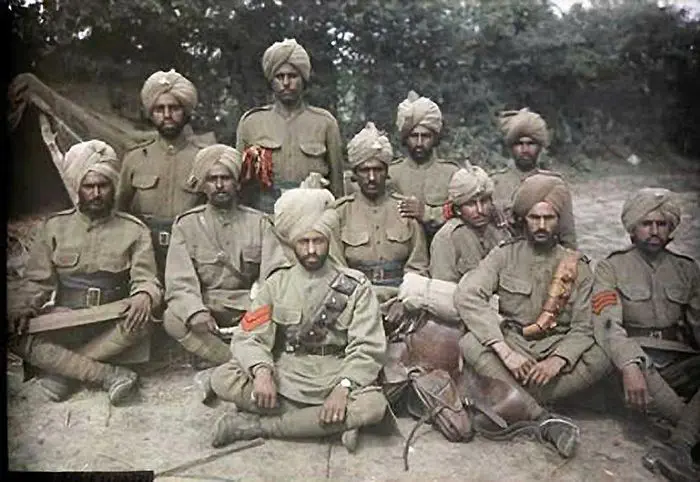
Constraints
There were many constraints to the participation, not only to the British Empire but also to the troops. It was a time when the 1857 mutiny and the Afghan campaigns were still in the memories of the British. It influenced policy within the Indian Army. Around this time, the Ottoman Empire had launched its pan-Islamic movements that held the Caliphate in Turkey in high esteem. Muslims in India were sympathetic to protecting it. This was also when the Indian Muslim League had formed with separate demands. The freedom movements in India were beginning to gain momentum. In 1903-4, Lord Kitchener, the C in C of the Indian Army, started re-organizing the army into field formations under commands and divisions. Preferring troops from newly found regions and loyalties.
Contributions: Expeditionary Forces (A to G)
The Indian contribution to the First World War was in the form of seven Expeditionary Forces (A to G). Fighting in the Western Front, East Africa Campaign, British East Africa, Mesopotamia, Sinai and Palestine, First Suez Offensive, and the Gallipoli Campaign. The Mesopotamia Campaign was almost entirely an Indian one.
It was Expeditionary Force G that fought in the Gallipoli Campaign. It comprised the 29th Indian Brigade, which had under its command four Infantry Battalions, namely:
- 14th (King Georges Own) Ferozepur Sikhs,
- 1/5th Gurkha Rifles (Frontier Force),
- 1/6th Gurkha Rifles and,
- 2/10th Gurkha Rifles.
An artillery component: 7th Mountain Artillery Brigade with 21st (Kohat) and the 26th (Jacob’s) Mountain Batteries. These batteries were equipped with breech-loading 10-pounder guns. These mountain batteries were the first to be reluctantly Indian-ised after the great mutiny of 1857.
Further, except for the Gurkha battalions, all other units had equal components of Muslim troops. The Ottoman Empire at that time held sway over the Islamic world. Indian troops were subject to Turkish propaganda. Thus, units with Muslim troops were quickly moved away to France. Leaving mainly the Gurkhas to fight it out in Gallipoli.
Services Units
There was also an Indian mule cart train of the Indian Supply and Transport Corps. Their services were vital for the operations of the entire Anzac. The lone Indian muleteer who stayed back to provide logistic support to Kiwis is part of folklore to date. All these units were further served by the 108th Indian Field Ambulance.
In addition, 69 Punjabis and 89 Punjabis, on their way to France and Flanders as part of 7th Indian Infantry Division were rerouted and sent to Gallipoli.
The Battles: Gallipoli
The Battle of Gallipoli had raged on two fronts, Anzac Cove and Cape Helles (see map on left), for three months since the invasion of 25 April 1915. With the Anzac landing in a tense stalemate, the allies had attempted to carry the offensive on the Helles battlefield at enormous cost for little gain.
In August, the British command proposed a new operation to reinvigorate the campaign by capturing the Sari Bair ridge, the high ground that dominated the middle of the peninsula above the Anzac landing.
Induction: 29 Indian Infantry Brigade
The troops that fought in Gallipoli, as part of Anzac, were the 29 Indian Infantry Brigade. The Indian brigade was dispatched from Egypt and attached to the British 29th Division which had been decimated in the earlier battles. The Anzac landing at Ari Burnu on the Aegean Sea (Anzac Cove) took place on 25 April 1915 simultaneously with the rest of the allies, including Indian troops, landing further south on the Gallipoli peninsula at Cape Helles.
In this Helles front, Krithia was an important objective, and several attempts were made to capture it. There were four battles fought over Krithia, and the Turks successfully defended it till the end.
Second and Third Battles of Krithia
The brigade was held in reserve for the Second Battle of Krithia, and they played a major part in the Third Battle of Krithia. Advancing on the left, the Brigade was quickly halted except along the Aegean shore, where the 1/6th Gurkha Rifles managed to advance. The 14th KGO Sikhs, advancing along the floor of Gully Ravine, were almost wiped out, losing 380 men out of 514 and 80% of their officers. The Brigade was next involved in the Battle of Gully Ravine, and here the 2/10th Gurkha Rifles managed to advance half a mile.
The Brigade next took part in the Battle of Sari Bair; under cover of a naval bombardment, the 1/6th Gurkha Rifles assaulted and captured the hill, which was then shelled by the Royal Navy. With their casualties mounting and under the command of the battalion medical officer, they were forced to withdraw to their starting positions.
By the end of the campaign, which by every account was a disaster, the Gurkhas had achieved their objective to overlook the spine of the peninsula. Thus, a piece of geography there was referred to as Gurkha Bluff.
The Indian Ambulance Brigade and Indian Mule Transport
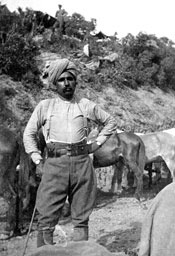 Many Gallipoli accounts remember the Indian Ambulance Brigade and the Indian Mule Transport.
Many Gallipoli accounts remember the Indian Ambulance Brigade and the Indian Mule Transport.
“The Anzacs called every Indian ‘Johnny’ and treated them like a brother, with the consequences that the Indians liked them even more … I often saw parties of Australians and New Zealanders sitting in the lines, eating chuppatties and talking to the men.” Major HM Alexander, Indian Mule Transport.
The spirit of Gallipoli lives on as battle honours in the regiments that exist even to date in the Indian Army, albeit under new titles. Indians who gave their supreme sacrifice in the Helles sector are commemorated on the memorial at Cape Helles, alongside the Twelve Tree Copse Memorial that commemorates the New Zealanders killed in the sector.
Memorials
India Gate, a prominent landmark in Delhi, one of the largest war memorials in India was designed by Sir Edwin Lutyens (who designed several buildings including the Lutyens Palace). Originally known as All India War Memorial it commemorates the 90,000 soldiers of the erstwhile British Indian Army who lost their lives fighting for the British Indian Empire, or more correctly the British Raj in First World War and three Afghan Wars. Names of those who sacrificed their lives at Gallipoli are also engraved on this memorial.
Indian soldiers were not eligible for the Victoria Cross until 1911; instead they received the Indian Order of Merit, an older decoration originally set up in the days of the East India Company rule in India. The honour of being the first Indian recipient of the Victoria Cross (VC) in any conflict went to Khudadad Khan, 129th Duke of Connaught’s Own Baluchis on 31 October 1914, at Hollebeke, Belgium. He was followed by 13 more Indians to be honoured with same award in First World War.
Anzac Day is seen and celebrated as marking a very important event in Australia and New Zealand’s history. Official publications state that the Gallipoli campaign helped New Zealand define itself as a nation, in that, after Gallipoli New Zealand had confidence in its distinct identity and pride in the international contribution it could make. Further, it is also held that the mutual respect earned during the fighting formed the basis of the close ties between Australia and New Zealand.
Acknowledgements exist
India’s contribution is acknowledged in several war memorials and battle honours bestowed on battalions and regiments, as well as in several personal accounts and books with a deep sense of comradeship with the Indian soldiers. However, in contrast, the spirit of Gallipoli, as seen in the Anzac and the comradeship that developed thereafter, seems to overlook the contributions of Indian troops. There could be many reasons for this unintentional amnesia. Foremost will be the fact that, as an erstwhile colony, India’s contribution was taken for granted and with no independent political resonance to back it up.
Next, the Indian Army in its history from 1757 to 1914 had on many occasions suffered heavier casualties, where whole battalions were wiped out. Thus, Gallipoli was not such a major milestone for the Indian Army as it was for Anzac. Further, during the Great War, 1914-1919, much heavier casualties were suffered in France and Flanders. It is in recorded history that 69 Punjabis and many other units during the Battle of Loos, on 25 September 1915, went into attack in the morning with 800 bayonet strength, and by evening muster, the tally was less than 150. The ferocity of the First World War was much more than anything so before or after, and the Gallipoli campaign was one of many that the Indian Army went through.
Second World War
Indian, Australian, and New Zealanders have had a long history of joint military operations. After Gallipoli, in the Second World War, the Indian Army was to number nearly 2 million men- the largest volunteer force in the history of human conflict. It was natural that the Indian troops would take to the field with their old Anzac companions. They did so in the battlefields of North Africa and later in the fierce fighting to roll back the Germans in Italy, in Burma, and in the Pacific theatre.
Indians and Anzac, who fought alongside in Gallipoli, had much more in common than merely being comrades in arms. They served like in the Charge of the Light Brigade … ‘not to reason why, but to do and die …’ Anzac Day needs to remember the Indian mates who served in Gallipoli.
What are your thoughts on India’s role in Anzac history? Share in the comments!
Scroll down to leave a comment.
Related articles
The Story of the Sappers of 12 Field Company

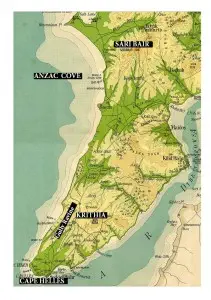


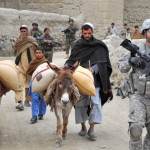
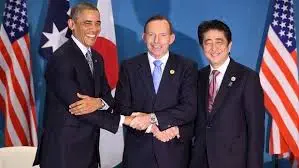



Also worth pointing out that the 89th Punjabis had the distinction of serving in more WW1 theatres than any unit in the British Empire having been at Sheikh Syed , the defence of the Suez Canal, Gallipoli, France and Flanders, Mesopotamia, North West Frontier, Salonika and Russia (trans Caucuses). Indeed I suspect that they may have served in more theatres than any individual battalion in any country’s army in the Great War
As an interesting side note. The Indian Army had already carried out the first opposed amphibious landing of the war when a Brigade strength operation was carried out in the Red Sea in November 1914. A Turkish fortress on the Sheikh Syed peninsular was deemed to be a threat to one of the main shipping channels into the Red Sea from the Indian Ocean and might interfere with British troop convoys to the Suez Canal. Turkish troops were building up in the area. Three battalions were used including the 69th and 89th Punjabis (which later went to Gallipoli). HMS Duke of Edinburgh an armoured cruiser with 9.2 inch guns (effectively a pre dreadnought battle cruiser) suppressed the forts artillery whilst the troops landed in flat bottomed horse boats. The terrain on the Sheikh Syed peninsular is not unlike that of the Gallipoli peninsular. In this case surprise was achieved and Turkish forces were rapidly forced to retreat. Indian Army engineers then blew up the fortress and the landing force re embarked for Egypt.
I’ve wondered whether the success of this operation gave a false impression of how easy it would be to bundle a Turkish force off the Gallipoli peninsular and influenced the decision for the landing.
Highly descriptive article, I liked that bit. Will there be a part 2?
In NZ there was little notye of the Indian and Gurkha action at Galipolli so I am grateful for these notes . Thank you. Edward
My five generations are born in Fiji. My first ancestor left India way before the world war 1, therefore I’m not biased in this. I have never been to India but I have been living in Australia for nearly 20 years and all I can say is that there are lot of Australians who don’t know the history of Anzac. Mos
Thank you Pradeep,
This certainly has redefined ‘ANZAC’.
I am certain many Australians have no idea about military contribution from India.
It is great that you are spreading the awareness.
Your friend,
Alfred
Thanks Bob,The war memorial in Delhi Cantt also has acknowledged the contribution of the I ndian Veterans.Another interesting historical connection we discovered was at Nicholson Square,near Kashmiri Gate,Delhi.A descendant member of late Brig Nicholson,the Garrison Commander,Col Brian Nicholson,Retd got in touch with us,and I showed him the site.It is heartening that the place is still referred to by the original name of Nicholson Square,despite the fact that the same gent was ruthless after the action and most of the native soldiers were executed.History should not be tampered with,however shameful the events….totally disregarded by our Congress party who have been at the helm of affairs for well over 5 decades since independence
Thanks Brajesh, today I attended a seminar at University of Technology Sydney where they had an afternoon to discuss the Indian effort in the first world war. Some interesting research done in France, Turkey and Germany. In Germany their archives have sound recordings of Indian POWs. Nothing can be better than that to know how Indian's felt fighting in a strange land. Will try and get more. On Anzac day an Indian, Sikh and Gurkha contingent marches with the parade. It will be great if we can get an Indian military Band on the next Anzac day. Perhaps through ICCR http://www.iccrindia.net/ … Thanks
A nice article indeed. The contribution of Indian soldiers during the world wars is yet to be recognized adequately in India both by people and also the Indian Army. What is recollected at best is some odd battles fought by the Regiments/ units from their recorded version(s). Near absence of native officers within the armed forces, apathy towards the British and fear of the military by the nascent democratic country soon after independence, has immensely contributed to this malady. A very nice article which brings the cooperation between the Indian & ANZAC during the operations; it deserves appreciation. these days, we are holding tactical level joint exercises with the armed forces of other countries to achieve interoperability between multifunctional forces. enjoyed reading, thank you Pradeep….
C
Interesting. I have a book written by my friend Yuan Tai on the Early explorations of the Australian continent by a Chinese Admiral long before anyone else. Indians came on ships as tindals, a term used for native sailors. In New Zealand, they deserted ship and fought on the side of the Maoris. Thanks for your comments Manjula.
Umesh Mehta Thank you for your kind comment.
i am proud of you, you do everything so perfectly that it brings happiness to all
Thank you for this article. I sent it to the President of the Brisbane Branch of the Global Organisation of People of Indian Origin (GOPIO) to include some words in his speech at the India Independece Day celebrations held on the 10th. He did! Infact it was a separate speech from the main one. The Minister for Multicultural Affairs also included mention of the Indian contribution in his speech. There are plans for GOPIO to join the ANZAC Day march next year. I believe the Fiji Indian Association already does so.
The Indian Javaan is always the unsung Hero
Anzac history shows Indian soldiers fought honourably alongside Australia and NZ and thus ANZAC soldiers in 1915 and soldiers from all three countries had a fond and long associatiion . History books by Australian historians Crytsal Jordan and Len Kenna reveal Indians explored Australia alongside the early British explorers from nineteenth Century. manjula
An interesting blog post.
Gallipoli is largely remembered as an Anzac battle and one that came to symbolise the futility of the First World War. Interesting to find out some details on the Indian army however.
Carl
Very well researched item placed on the blog.
It would be nice if you start documenting the the stories regarding Gen VK’s controversy in the correct perspective for the sake of posterity.
Good writing, Bash on Regardless.
Rana.
Thanks Pradeep, for a well researched and informative article. The history during this period, of the Indian Army units & formations is not well documented.
Enjoyed reading!!
Thanks Brajesh
You sure know mil history very well and researched further. Keep it up.
Thanks Hira. Look forward to your contributions.